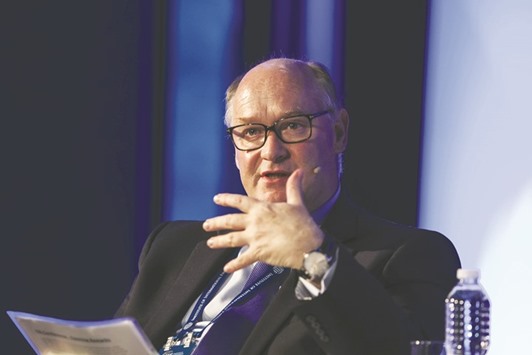After years spent clamping down on risky behaviour at banks and punishing them for past misdeeds, Europe’s regulators have awoken to a new worry: lenders aren’t making enough money.
Shrinking profitability has become a “concern for financial stability” because it may reduce banks’ ability to recover from shocks by generating capital or selling stock, Bank of England governor Mark Carney said on November 30. The week before, European Central Bank President Mario Draghi said profitability “remains a challenge to be addressed.”
The issue has come to the fore after Europe’s banks endured yet another trying year. Financial stocks tumbled from January to July on the back of escalated capital requirements, ultra-low interest rates and Brexit worries, only to recoup some of those losses on speculation Donald Trump’s presidency may bring regulatory relief.
“Banks have a chronic profitability problem,” said Antony Jenkins, the former chief executive officer of Barclays who went on to found cloud-computing company 10X Future Technologies. “It’s important that regulators and executives address it.”
Return on equity, a key measure of profitability, sank to 5.7% at European Union banks as of June, a decline of more than a percentage point from a year earlier, according to the European Banking Authority. In Britain, Royal Bank of Scotland Group, HSBC Holdings and Standard Chartered all watered down or pushed back profit goals this year.
“We intend to look at exactly this issue: what are the factors affecting the profitability of banks and what steps are they taking in their current strategic plans” to improve returns and to maintain resilience? Carney said. “In other words, are they accrediting capital or are they gradually shedding capital, and what do they need to do?”
The Bank of England, in next year’s stress tests, will examine whether the industry can endure a prolonged period of low rates and weak growth, and how banks might alter their business models to boost returns and ensure their viability. The ECB, in its financial stability review last month, said variations in profitability across the EU suggest “some banks have considerable room for improving operational efficiency,” either by cutting costs on their own or merging.
While American banks have faced their own profitability concerns, those have been eased by geopolitical events. The US banks’ trading arms were well-placed to harness the surge in activity precipitated by Brexit, and Trump’s election has sparked hope of more fiscal stimulus to spur growth. Central banks in Europe have called for stimulus from their governments since the crisis, with little result.
With less help from the broader economy, one way for European regulators to help banks become more profitable “might be to facilitate or encourage more consolidation,” HSBC chairman Douglas Flint said in a Bloomberg Television interview. “If I were a regulator, the thing that protects the system more than anything else is the generation of capital, rather than the raising of capital when it’s lost.”
A frustration for top bankers is that the profitability investors demand hasn’t come down even after lenders piled up hundreds of billions more in loss-absorbing capital, closed risky trading desks and beefed-up compliance and culture programmes.
Banks’ cost of equity — an estimate of the return on equity that investors expect — is still around 10%, the same as before the financial crisis. On the flip side, lenders’ returns on equity are likely to remain stuck in single digits for some time.
“At the moment, banks are destroying shareholder value and will find it harder to attract more equity,” said Nick Hill, managing director of banking at Moody’s Investors Service. “The main lever a bank can truly influence is the cost one, which is why we are seeing these relatively aggressive cost plans across the whole sector.”
Even those measures can only help so much. UniCredit, Italy’s largest bank, announced plans last week to slash 14% of its workforce and shut almost a quarter of its branches in western Europe, while disposing of bad loans and raising €13bn from investors. Even after that overhaul, it foresees a return on tangible equity of 9% in 2019.
Some executives, who’ve argued for years that shareholders must accept lower returns in exchange for a safer banking system, now want help reassuring investors. Central bankers should say what they consider an appropriate return on equity within the post-crisis framework of capital requirements and rules they’ve helped put in place, said members of the executive committee at two of Europe’s largest firms. That would help re- base expectations for cost of equity, they said.
While asking regulators for public profitability targets would’ve been almost unthinkable a decade ago, successive banking CEOs have been unable to stem stock declines that have left firms trading at a fraction of their worth on paper. With such low valuations, European banks may struggle to raise equity if hit by another large fine, said the executives pushing the idea of a return target, who asked not to be identified telling regulators what to do. Profitability has become a prudential issue and should be addressed by regulators, they said.
There’s little evidence the idea will catch on. John Vickers, who as chairman of the 2011 Independent Commission on Banking was the chief architect of the post-crisis overhaul of the UK financial industry, called the notion that regulators should tell investors what return to expect “odd and unnatural.”
Others suggest rule makers should stay out of the way before they do more harm.
Natasha Sarin and Larry Summers, in a September paper titled “Have Big Banks Gotten Safer?” argued “that an overhang of likely future regulatory actions” have paradoxically made banks riskier than before the crisis because investors, unable to predict what lenders will earn, were shunning them.
Low profitability concerns bondholders as well as shareholders. At a September conference hosted by Fitch Ratings, 47% of those present said earnings were the main risk for creditors of western European banks, outstripping the more headline-grabbing issue of Brexit, which got only 4% of votes.
Bank CEOs have become increasingly frank about how they’re perceived. Credit Suisse Group’s Tidjane Thiam, at a Bloomberg conference in London on September 28, suggested the gap between investors’ expectations and lenders’ returns “makes banks not really investable as a sector.”
Jon Cunliffe, the BoE deputy governor for financial stability, has said he’s investigating the disparity between investors’ demands for earnings and what the industry can generate in the post-crisis world. It’s an issue that needs to be resolved, for the health of the financial system.
“An unprofitable banking system can’t absorb shocks, and you’re asking shareholders to put money into a model they don’t actually think generates the capital return that they require,” HSBC’s Flint said. “Therefore, there’s more likelihood of losses being forced onto debt holders or ultimately some kind of public support.”

With less help from the broader economy, one way for European regulators to help banks become more profitable u201cmight be to facilitate or encourage more consolidation,u201d says HSBC chairman Douglas Flint.


